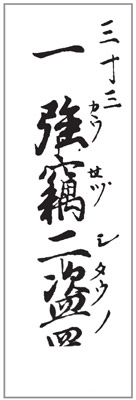Read In Search of the Niinja Online
Authors: Antony Cummins
In Search of the Niinja (5 page)

The four ideograms.
As you can see, a literal translation would ‘by force, by creeping, two [ways] of stealing’. For a native Japanese speaker of the thirteenth century this would reference two methods of theft, terms still used in the Japanese language today. The first two single ideograms can be added to the last ideogram in the example. Here is how it would look:
• |
|
|
• |
|
|
It is the second example of (
(
Setto
or
shinobi) that is of interest to us and whilst on its own the find is not significant, when it is combined with other elements it becomes hugely important.
The term , as explained above, has multiple interpretations in Japan, one of which is
, as explained above, has multiple interpretations in Japan, one of which is
Setto
and the other of course is shinobi
.
14
Remember that in this thirteenth-century case, it is not the name of a position or title, because the syntax demands ‘the art of stealing into a house by using creeping methods’. The amazing fact here is that it is samurai who were using the art of infiltration to break into domestic buildings and steal for profit. It refers to early shinobi-like activity by the military class in a time of relative peace. It shows that the samurai were ‘restless’ and using their skills for personal gain. We also see that 150 years later, the
Taheiki
war chronicle mentions samurai who have special infiltration skills and talks about them as ‘shinobi’ whose skills are identical, that is they ‘creep in’ and infiltrate, but this time it is for the purpose of destruction. So these ‘ninja’ skills are considered of military value in wartime but when in times of peace, such skills could be and were used for personal gain and were therefore classed as a crime.
15
We see the ideograms being used to mean samurai who steal by stealth and later used to represent the military figure, the shinobi.
being used to mean samurai who steal by stealth and later used to represent the military figure, the shinobi.
The relationship between military infiltration (shinobi) and theft (
Nusubito
/
Tozoku
) becomes more complicated as time progresses. By the mid 1500s the ideograms of explained above and the classic example of
explained above and the classic example of both have identical readings and both are recorded with the phonetics ‘shinobi’.
both have identical readings and both are recorded with the phonetics ‘shinobi’.
What does this mean? It means that by the end of the 1300s, people understood that a shinobi was a person who infiltrated camps or houses and that the word shinobi could be written in the two ways, that is and
and . It is only by considering the individual context of each example that a reader can determine if it is the name of a specialised person (a shinobi) or if it is the action of creeping in.
. It is only by considering the individual context of each example that a reader can determine if it is the name of a specialised person (a shinobi) or if it is the action of creeping in.

 force and
force and stealing
stealing
 creeping and
creeping and stealing
stealing